

Woljeongsa Temple at
Odaesan Mountain,
Pyeongchang’s Treasure
Travelling to Gangwon-do,
A Winter Gem
When you’re in Pyeongchang, the main host city for the PyeongChang 2018 Olympic and Paralympic Winter Games, take the chance to visit Odaesan Mountain National Park, where natural beauty meets ancient history and traditions. The landscape includes forests that humble all worldly concerns, temples where the chaotic emotions of the real world are cast side in the enlightenment of prayer, and tranquil hermitages that inspire a spirit of tolerance. Get to know Odaesan Mountain in February, the heart of winter.
Written by Park Ji-yeon Photographed by Studio Kenn
Illustrated by Hagogo

Templestay
A templestay is a religious experience for laypeople where visitors get to live like a Buddhist monk in a temple, living and breathing the history and heritage of the religion. It's sought after by those who wish to rest or to find enlightenment in the solitude of nature and the temple. It's popular among visitors of all ages and groupings, from solo travelers to couples and families. Woljeongsa Temple offers a templestay program for foreigners, as well, breaking down the barriers of nationality and language to achieve communication and mutual understanding among all humankind.
Toewoo Jeongnyeom, the Chief Monk of Woljeongsa Temple, hopes that the Templestay program will not only provide an opportunity for religious introspection and enlightenment, but also true rest.
Toewoo Jeongnyeom, the Chief Monk of Woljeongsa Temple ;
Join the Woljeongsa Templstay to comfort your weary soul and reflect on the busy path you have walked so far. Walk on the wide fir forest path, holding hands with family and friends in silence. Just the affectionate warmth from the hand in yours will give you great comfort and strength. Open your ears to the sounds of nature, and take a quiet look inside your heart.
“The forest path of a thousand years and Woljeongsa Temple do not become worldly because thousands of people have been through them. They stay the same as they ever were.”
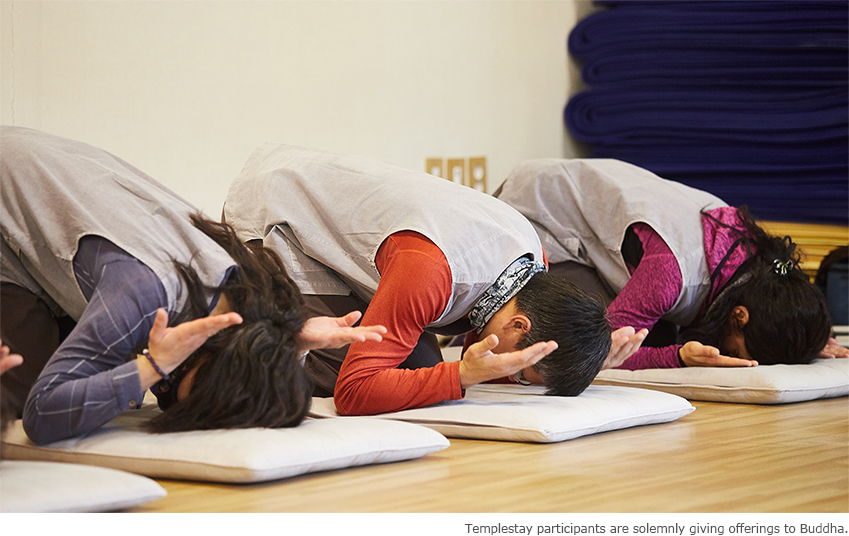
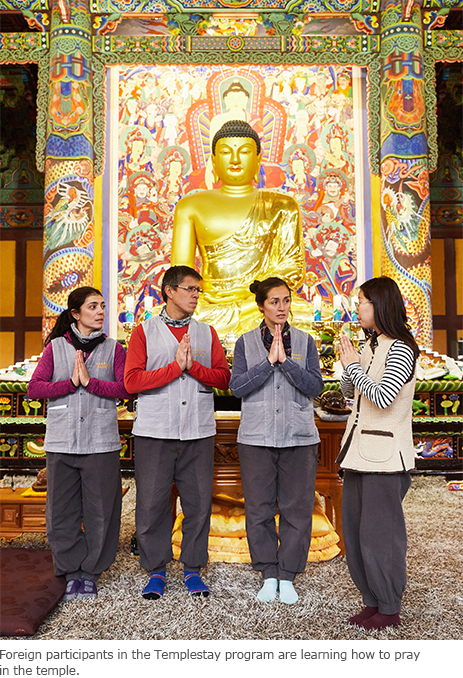

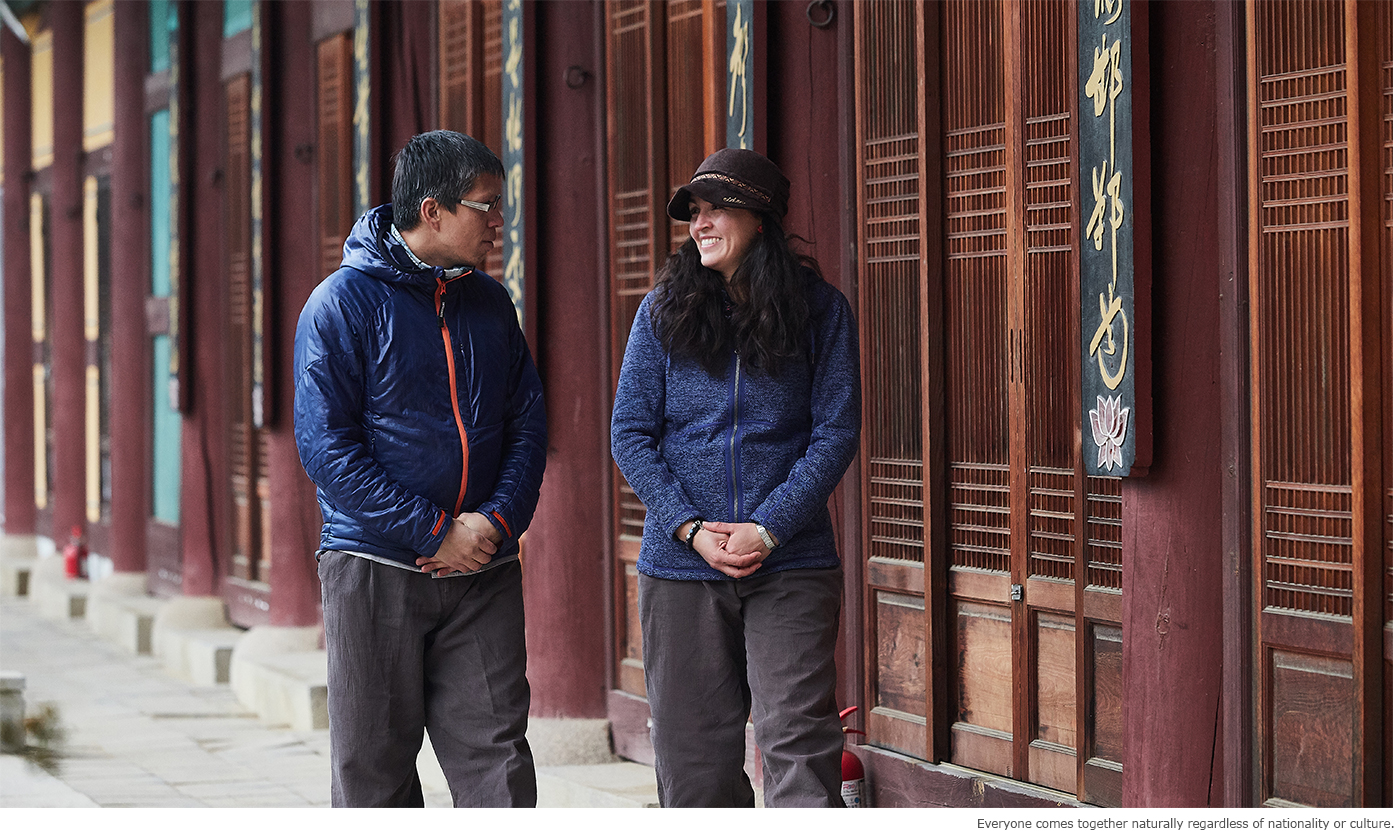
A stay at Woljeongsa Temple is spiritually healing, blessed as it is with the sheer beauty of Odaesan Mountain and the ancient temple. However, a proper templestay is recommended for the full experience of life at a temple and to experience Buddhist asceticism. Participants are taught proper etiquette and the sound of the four samul objects in preparation for the religious service. They eat the food at the temple and meditate, putting away their worldly obsessions. Walking in the fir forest under the light of the moon also offers a unique experience, different from the walk during the daytime.
One participant we met had high praise for the night spent at the temple, sharing that waking up early in morning at 3:50 a.m. was like being awake while the whole world slept, and saying that the 108 prostrations were a lesson in overcoming one’s own limitations. They vowed to return with loved ones next time.
Woljeongsa Templestay Program
Through the Woljeongsa templestay program, participants can not only learn about the religious characteristics of Buddhism, but also gain appreciation for the beautiful landscape and rich cultural heritage.
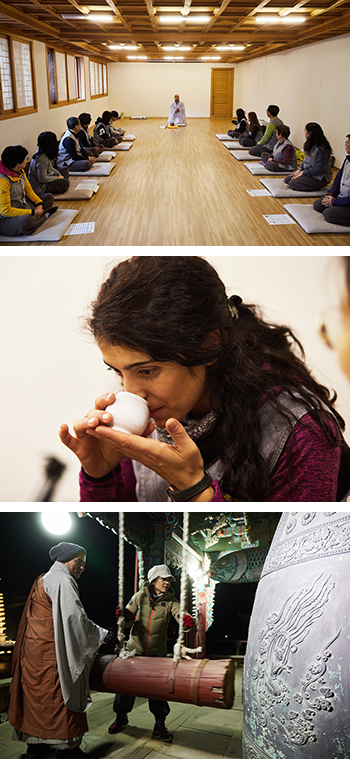
-
Yebul
The Yebul is a ceremonial service that pays respect to Gautama Buddha and his disciples. Participants must attend a Yebul in the early morning and in the evening.
Balwoo gongyang
The gongyang are the three daily meals eaten at a temple. The Balwoo gongyang embodies the spirit of equality, which is a key virtue of Buddhism.
Temple Etiquette
A temple etiquette session teaches basic manners that must be adhered to at temples, to ensure harmony among visitors and monks.
Tea Time With Monks
Enjoy a cup of tea with the monks at Woljeongsa Temple as they share their wisdom and experiences.
Bell Striking
At 6:10 p.m. every day, the temple holds a traditional instrument demonstration. Templestay participants can enjoy the rare opportunity to strike the temple bell themselves.
108 Prostrations
Immerse yourself in the meditative music and prayers while focusing on the movement of your body. At the end of the routine, you will be filled with gratitude and reach a state of inner peace.
In addition to the above, the templestay program includes meditative forest walks, a visit to the Seongbo Museum and a chamseon Zen meditation session.
Recharging at Odaesan Mountain
and Woljeongsa Temple
On the way back, after a stay at Woljeongsa Temple, one passes through the scenic landscape of Odaesan Mountain once more. The fir forest serves as a gateway, both away from and back into, the real world. Walking back along the path after an intense worship session feels like going home after sweating it out in a sauna, with a pleasant lethargy that feels calm but not heavy. Ending the spiritual retreat and walking back into the world, one might give oneself a pat on the back, saying, “Good job, friend.” Visit Weoljeongsa Temple at Odaesan Mountain to listen to the voice of your heart, and to feel that voice awakening your soul. This voice will be the gift of Odaesan Mountain to the attentive travelers who hear its call.

Trip Points
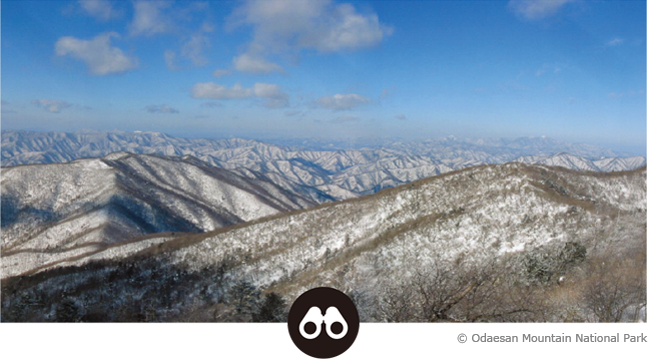
Odaesan Mountain
National Park
Odaesan Mountain National Park, which stretches over an area of 326.35 square kilometers/ 126 square miles, was designated as Korea's 11th national park in 1975. It consists of five peaks. The main Birobong Peak rises 1,563 m/ 5,128 ft. above sea level. Then there's Dongdaesan Peak (1,434 m/ 4,705 ft.), Durobong Peak (1,422 m/ 4,665 ft.), Sangwangbong Peak (1,491 m/ 4,892 ft.) and Horyeongbong Peak (1,561 m/ 5,121 ft.). All of these peaks rise above 1,000 m/ 3,281 ft., forming a formidable ridge. It's also a historical site where the Odaesan Royal Archives used to hold the Annals of the Joseon Dynasty, and a holy site in honor of the bodhisattva Manjushri. It's home to Woljeongsa Temple, an ancient shrine with over 1,000 years of history, founded by Monk Ja Jang (자장율사, 慈藏律師) under the reign of Queen Seondeok of Shilla (선덕여왕, 善德女王). The five peaks, consisting of the central peak, home to Woljeongsa Temple, together with the four surrounding peaks, give Odaesan Mountain its name: the Mountain of the Five Platforms.
※ The Jeokmyeolbogung: a shrine for the Buddha's sarira
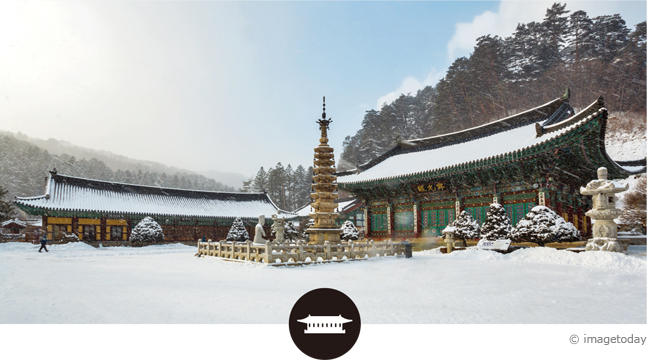
Treasures of Woljeongsa,
A Feast for the Eyes
Woljeongsa Temple sits deep in the heart of an evergreen forest, which remains verdant all year round. It has an air of tranquility, in deep meditation, far from the noise of the world. Lives are filled with prayerful devotion along the forest paths and in the still air of the temple grounds and the shrines. Walking onto the temple grounds, one is immediately greeted by the Octagonal Nine-story Stone Pagoda, National Treasure No. 48, standing tall like a watchman. Made of imperishable rock, it remains intact to this day, having passed the test of time. The stone pagoda was built in the 900s during Goryeo times and stands 15.2 m/ 50 ft. tall, making it the tallest octagonal stone pagoda in Korea and a fine example of a Goryeo stone pagoda.
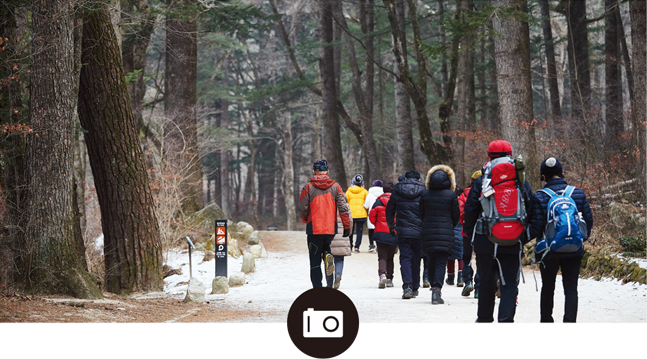
Fir Forest Path of
Enlightenment and Healing
Most visitors to Odaesan Mountain National Park walk the fir-lined path as it forms the gateway to the ancient Woljeongsa Temple. Over 2,000 firs form a thick and tall forest reaching to the sky, purifying the air and whispering their centuries-old stories to every new visitor. Walking in the heart of the forest, listening to the trees breathe, one tends to forget the worries of the world. Before you know it, you're at the entrance to Woljeongsa Temple, your mind ever more free from worldly concerns with every step.
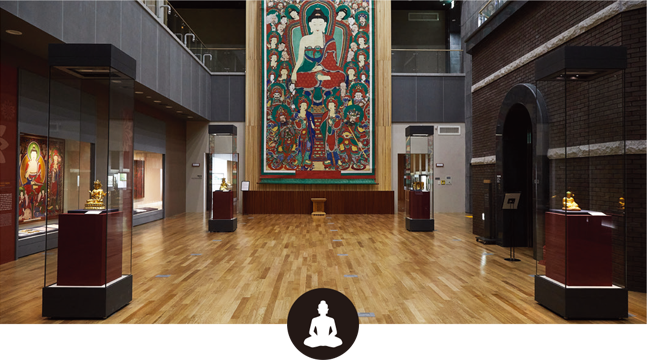
Seongbo Museum
Woljeongsa Temple has a beautiful name, meaning "where the moon stops." It offers even greater beauty in the "moon of the heart," accessible through enlightenment. Located atop a mountain that is a holy religious site in itself, Woljeongsa Temple holds many rare historical treasures. After you admire the stone pagoda, head to the Seongbo Museum. There you will find many precious artifacts on display, such as a copy of the Tripitaka Koreana printed in 1865 during the second year of the reign of King Gojong, as well as 12 sarira containers discovered in the octagonal nine-story stone pagoda.
Odaesan Mountain Travel Map
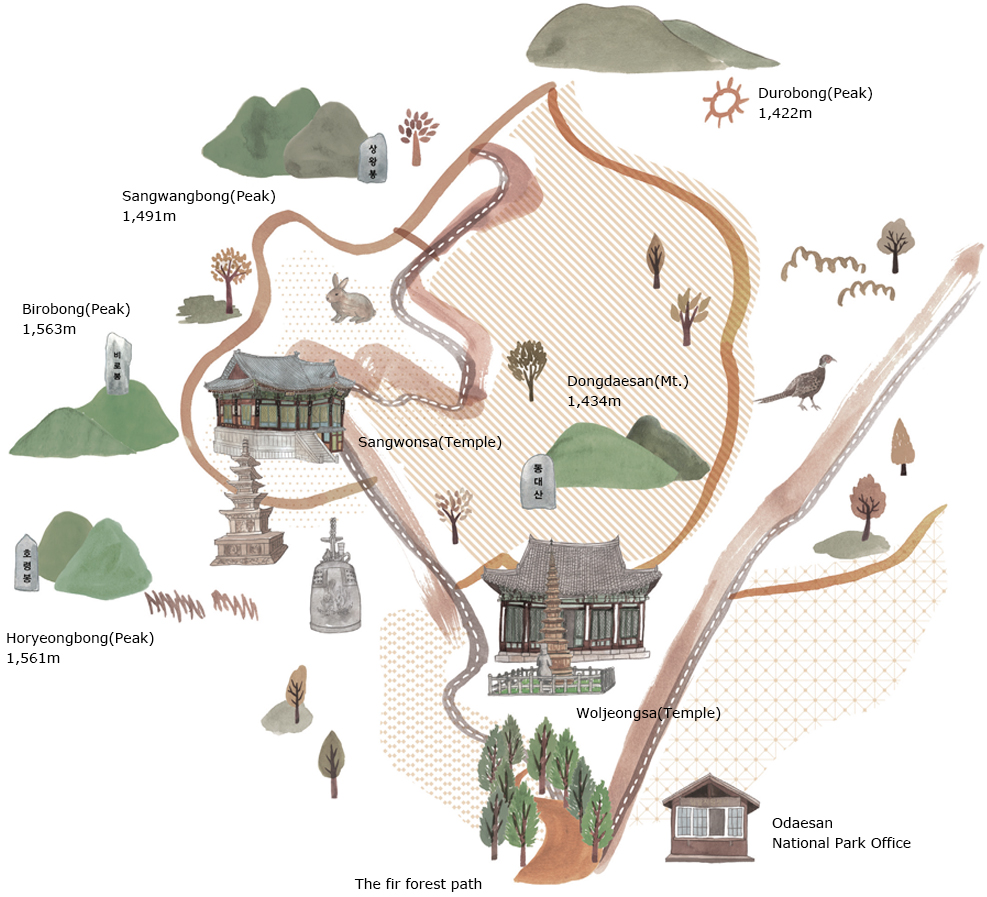
Travel Tip
-
Odaesan National Park Office
Registration Instruction
340, Jingogae-ro, Jinbu-myeon, Pyeongchang-gun, Gangwon-do
Language
Korean, English, Japanese, Chinese
Interpretation Service by Volunteers for PyeongChang Olympics
English, Japanese, Chinese, French, German
-
Odaesan Mountain Hiking Course
Duroryeong Pass-Durobong Peak-Dongdaesan Mountain-Jingogae
- 10 km one-way, approx. 5 hr (Advanced) Sangwonsa Temple-Jeokmyeolbogung-Birobong Peak
- 7 km round trip, approx. 3 hr 30 min (Moderate) Seonjae-gil (Woljeongsa Temple-Sangwonsa Temple)
- 10 km, approx. 3 hr 30 min (Easy)
* View maps for each course on the Korea National Park Service website (english.knps.or.kr). -
Service Hours
10:00-7:00
Tour Information Desk
- +82-33-332-6417 Odaesan National Park Office
- +82-33-330-2772 Woljeongsa Temple Tourist Information Center
- +82-33-339-6606 Woljeongsa Templestay
- +82-33-339-6607 Woljeongsa Temple Foreign
Language Service Customer Service Operating Hours
09:00-18:00
Other Articles




Odaesan Mountain,
Pyeongchang’s Treasure

Hooked on Hangeul

Designed To Be ‘Held’


Eomuk Fishcakes


With Culture N Tickets
Application of subscription
Sign upThe event winners
Go






